Special Seating (*)
A. Best guide and best seat
Children with cerebral palsy need seating which can enable them to have more body control, especially control of their head and limbs.
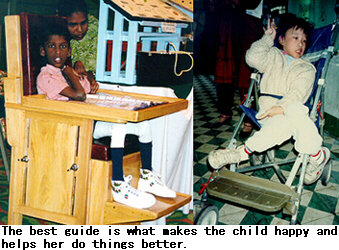
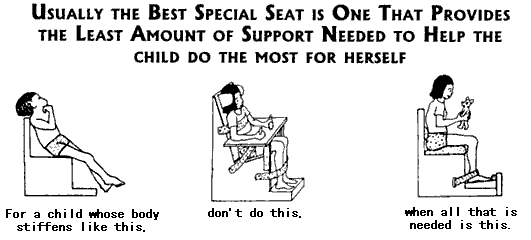
B. Using paper and other materials to make special seats
Appropriate paper-based technology can be used to make special seats for children with disabilities. As the children's needs change, it is necessary to design and adapt seats that:
- Meet the specific needs of the individual child (and whoever cares for her);
- Fit into the local social and physical environment;
- Are low cost, so the families or communities can afford them;
- Are simple and easy enough to make, so that the families can adapt or remake them as the children and their needs change.
In addition to cardboard boxes and paper, a great variety of other materials can be used: sticks, logs, wood, plywood, plastic, metal rod, even mud.
Seats also range from simple to complex. The design depends on the child's particular needs and stage of development. Some seats serve mainly to keep spastic legs separated; others help a child sit in a more functional position. Some seats are designed to reduce muscle tone in a spastic child; others are designed to increase tone in a floppy (flaccid) child. Here is a sampling of different seating designs:
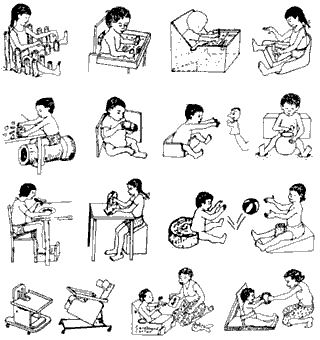
Special seating should enable a disabled child to sit in a more comfortable position, do more with the minimum level of support needed and to interact more with the environment around her/him.
However, there is a tendency to focus more on making the seat according to instructional manuals, rather than on adopting a trial-and error approach to ensure that the equipment meets each child's specific needs and is appropriate for her/him. What works well for one child may not work well for others.
Some common problems in "standard" special seating are illustrated below.
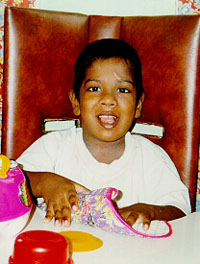
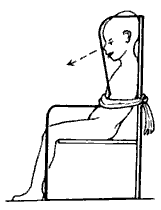
The problems are clearer when we look at the seat from the side:
The sides of the head-rest are too far forward.
They block the child's vision to the sides.
The seat belt is too high. It causes, rather than prevents, slumping. Also, the belt provides no sideways stability because it passes around the sides of the chair.
The seat is too deep. The knees bent over its front edge force the child to slump with rounded back and extended hips: a tiring and harmful posture. It could increase spasticity.
The back of the chair pushes the child's head forward, lowering his line of vision. This makes it harder for him to watch activities around him, which can delay his development.
Danger of falling. The chair tips back slightly but with no safety supports to prevent it from falling over backward. This is especially risky because the feet are on the ground. (There is no footrest.) A child with spasticity could easily push the seat over backwards.
If the child shown above has spasticity, the slouched position that the seat provides could trigger backward stiffening of the body, thus requiring the seat-belt to keep him in the seat. A few basic principles of seating and positioning of such children are shown below in simplified form. (Side supports and armrests, which may also be needed, are not shown in these drawings.)
To find out which of these or other options is likely to work best for an individual child experimentation is necessary, paying attention to the child's wishes and responses.
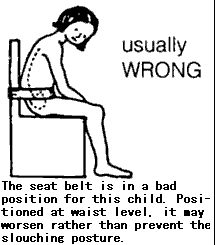
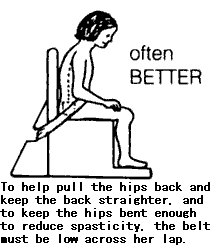
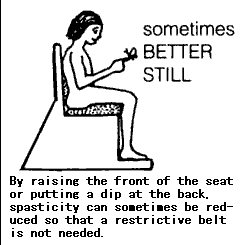
It is often helpful if the seating is adjustable, allowing the child to sit in positions for stimulation as well as for relaxation.
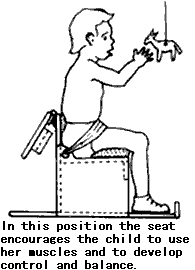
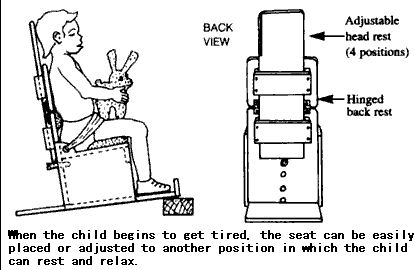
Design a seat that helps a child to lift his head and use his hands.
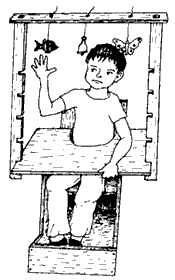
The idea for the "merry-go-round" comes from a rehabilitation playground in Thailand.
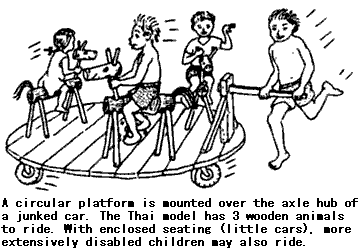
One way to mount the platform of a merry-go-round:
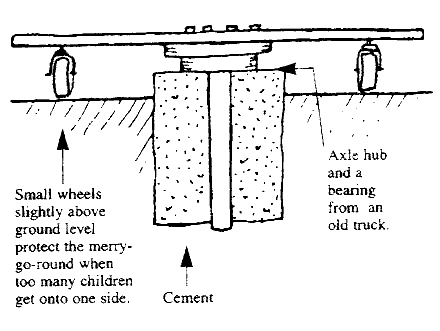
C. Special seating on wheels
Wheels can be put onto special seats, for the benefit of both the child and her care-providers (mother, brothers and sisters, or others). The mobility (movement on wheels) achieved stimulates the child's development: exploration of her environment, enjoyment, physical coordination, self-reliance. And for the mother of an older, heavier child, being able to push her in a wheelchair, rather than have to always lift and carry her, makes moving her easier and protects her back.
Special seats can be built to fit into a standard wheelchair. Or wheels can be attached directly to the special seat. Here are some examples of different forms of special seats on wheels:
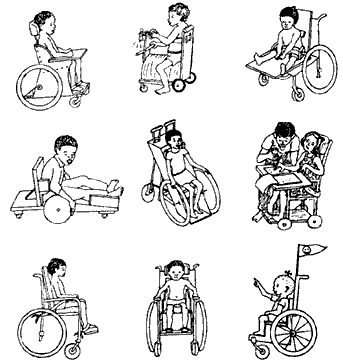
Adjustable seat tilt for a child with cerebral palsy who needs forward-tilted seating alternating with rest periods during which the seat is tilted backward.
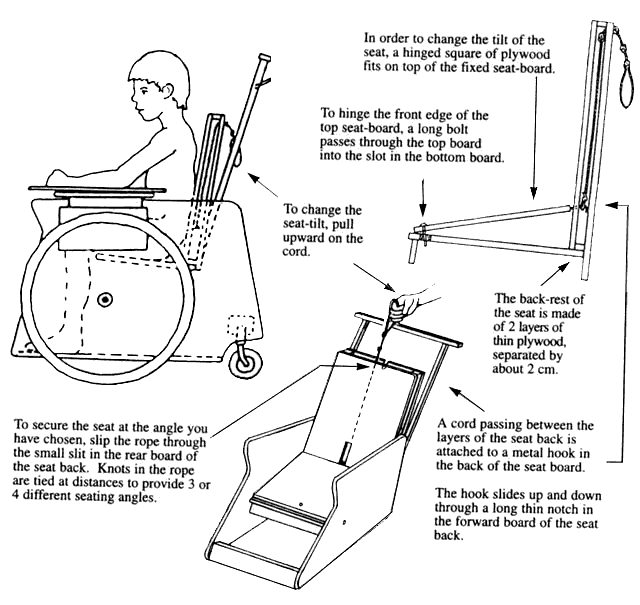
Changing the slope of the seat changes the height of the child relative to the table. Therefore the table height has to be adjustable. Below is a simple design that allows adjustments of both the table height and angle.
The many adjustable features of this chair allow the family and child to experiment with different combinations of adjustments, to find out what works best for the individual child.
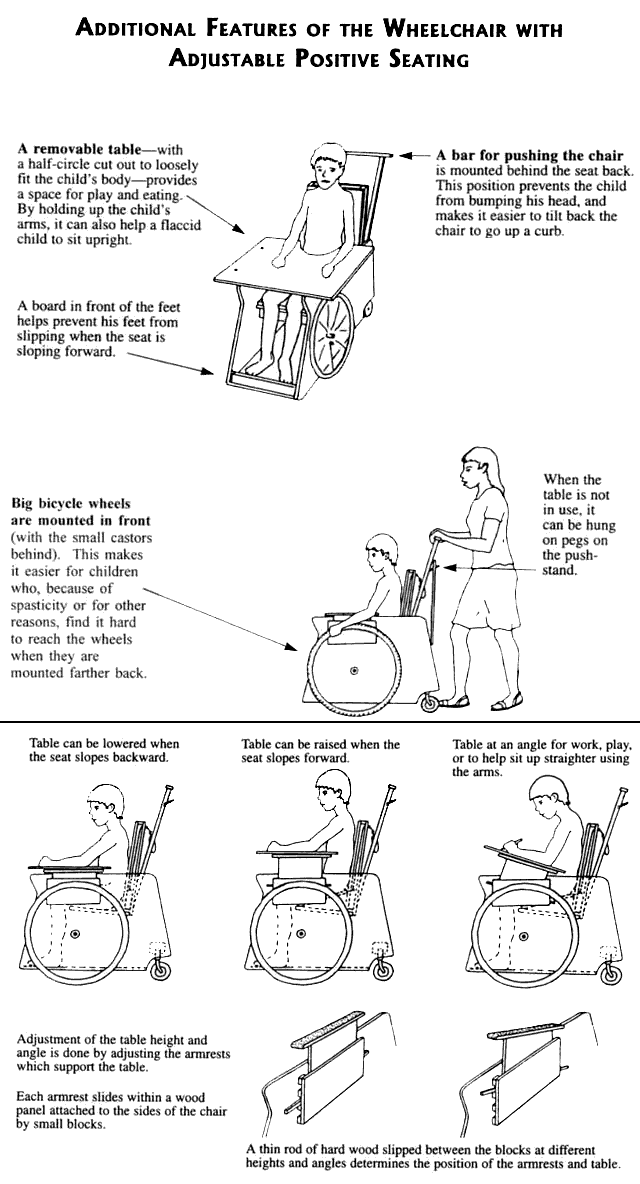
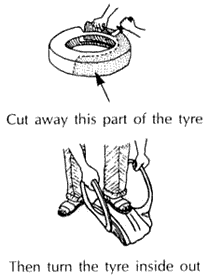
D. Recycling a rubber tyre into a swing
Below is an innovation of the Programme of Rehabilitation Organized by Disabled Youth of Western Mexico (PROJIMO) team. The innovation involves using an old rubber tyre to make a tyre swing, to reduce spasticity and develop more body control.
An innovation: A tyre swing as an effective seating arrangement. It can be made like this.
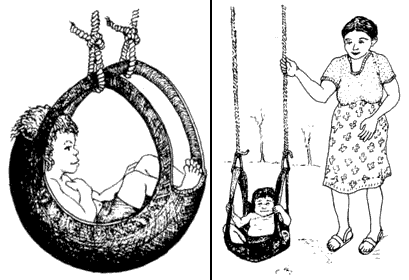
The double curve of the tyre gently bends the child's head, shoulders, and hips forward. And it holds her legs in a bent, relaxed position.
In the tyre swing, the child has much more head and hand control and little sign of spasticity.
She is even able to reach forward and hold the tyre rim.
Problems: Shortcomings of the tyre swing are: (1) It is suspended in one location and cannot be easily moved. (2) For many other children, a spastic pattern can be better reduced by flexing the hips to a 90-degree angle, which the tyre swing does not do. (3) The tyre holds the child in a semi-reclining position. But, for maximum function, it often helps to sit more upright.
Usefulness for other disabled children: This kind of swing has been used in many countries, both in children's playgrounds and for rehabilitation of children with physical and mental delay. However, its potential as a device for special seating, especially for children with spastic cerebral palsy, still needs to be more fully recognized and implemented.
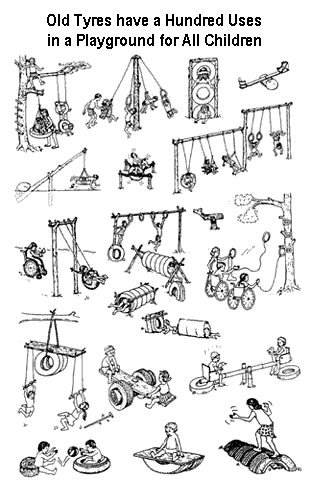
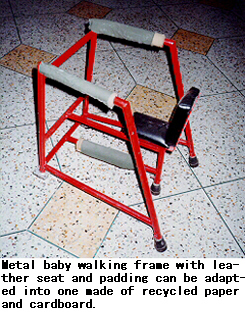
HEARING AIDS
Maintenance tips
(a) Do not wear a hearing aid while sleeping or bathing.
(b) After use every day, clean a hearing aid with a cloth to remove moisture, dust and other contaminants.
(c) Remove the battery at bed time.
(d) Remove the cord, clean the pins and keep them in a plastic bag.
(e) Check the battery contacts and, using a cloth or sandpaper, remove any deposits on them.
(f) When possible, avoid exposing a hearing aid to excessive moisture, dust or heat.
(g) Be aware of the clarity and intensity of sound. Variation from the normal may indicate low battery power. It may also be due to loose contacts, loose switches or damage in the cord.
(h) Using a battery once the sound quality deteriorates may lead to discharge from the battery, which can damage the battery compartment and contacts.
(i) If the hearing aid produces a whistling sound, adjust the ear mould fitting, increase the distance between the earphone and the aid, or reduce the volume.
(j) Do not drop the hearing aid or parts of it. Handle the aid only while sitting on a bed or on the floor, to ensure that it does not fall to the ground.
(k) Switch off the hearing aid when not using it.
(l) Do not use extreme settings on the hearing aid if they are not required.
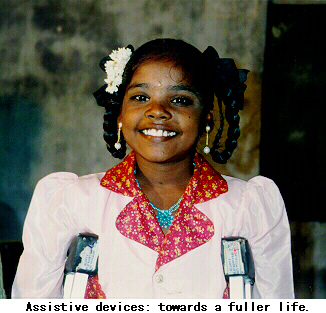
* Source: David Werner, "Nothing about Us without Us: Developing Innovative Technologies For, By and With Disabled Persons. HealthWrights 1998, Palo, Alto, California, U.S.A.
Go back to the Contents
ECONOMIC AND SOCIAL COMMISSION FOR ASIA AND THE PACIFIC
Production and distribution of assistive devices for people with disabilities: Supplement3
- Chapter 5&6 -
ST/ESCAP/1774
UNITED NATIONS PUBLICATION
Sales No. E.98.II.F.7
Copyright © United Nations 1997
ISBN: 92-1-119775-9
